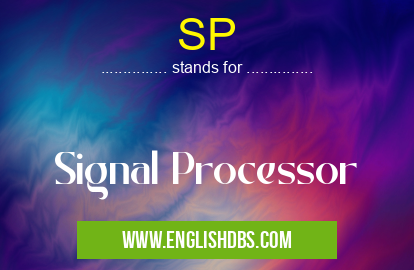What does SP mean in ELECTRONICS
A signal processor is an electronic device that receives, processes and transforms electrical signals to create a desired output. It allows us to increase the clarity, accuracy or intensity of the original signal. Signal processors are commonly used in audio and video equipment such as amplifiers, equalizers, and synthesizers.

SP meaning in Electronics in Academic & Science
SP mostly used in an acronym Electronics in Category Academic & Science that means Signal Processor
Shorthand: SP,
Full Form: Signal Processor
For more information of "Signal Processor", see the section below.
Essential Questions and Answers on Signal Processor in "SCIENCE»ELECTRONICS"
What is a signal processor?
How does a signal processor work?
A signal processor works by collecting electronic signals from an input source such as a microphone or a line-in connection. The signal is then processed through multiple algorithms which can include compression, reverb, EQ (equalization) and more. These filters manipulate the properties of the incoming sound to produce an altered output based on the settings applied.
What is the purpose of using a signal processor?
The primary purpose of using a signal processor is to enhance or change audio signals for various applications, such as music production, post-production workflows or live sound reinforcement. Signal processors can be used to add effects like chorus or delay; shape frequencies with equalizers; boost or reduce levels of certain sounds; eliminate unwanted noise; compress dynamic range; and many other functions depending on the particular model in use.
What types of audio signals can be processed with a signal processor?
Nearly any type of digital or analog audio signals can be processed with a signal processor; however, most modern processors are designed to work primarily with digital audio signals due to their increased flexibility and precision controls. Many models also offer additional features specifically tailored for processing specific types of audio sources like vocals, drums, guitars etc., allowing for more efficient shaping of those sound sources during production stages.
What components make up a typical signal processor?
A typical basic setup will typically consist of an input stage where all incoming audio from external sources is converted into digital format; several preprocessing modules - each handling different tasks such as filtering out unwanted noise; modulation functions such delay/echo/chorus/flange effects etc.; an output module that converts data into required format before sending it out again - usually back into analog format in case external speakers are being used as final output devices; finally there will be some kind of controller module either built in or connected externally that allows you make adjustments to all these parameters in real-time.
Is there any benefit to using combined processors?
Yes! Using combined processors instead individual units allows you to save space while simultaneously having access to multiple effects in one convenient package. This way you can quickly switch between effect combinations without needing time consuming plugging/unplugging between devices which could otherwise lead loss of precious time during rehearsals/recording sessions etc.
Are there any drawbacks with using dedicated hardware versus software-based solutions?
Dedicated hardware solutions typically cost more than software-based ones and require complex installation procedures before they become operational - although once they’re installed they generally provide better performance than their software counterparts due to not being limited by CPU power & RAM resources available on computers etc.
What features should I look for when buying a new signal processor?
Some important factors include number & quality of effects offered (many high-end units come packed with dozens upon dozens of different presets), compatibility with your current studio setup – i.e whether it supports both input & output connections needed by your hardware (and if it has enough connections!), pricing – always ensure it fits within your budget constraints & lastly ease-of-use – some processors come with intuitive interfaces others require manual programming knowledge so always double check before purchasing!
Can I connect multiple devices at once when using a signal processor?
Generally yes – most dedicated all-in-one processors offer at least two separate inputs so you're able to achieve ‘stereo’ mixes when recording live sessions etc., while more advanced models may also support simultaneous usage from multiple inputs for even fuller mixes (or ‘multi-channeling’). In addition many digital mixers allow direct integration with existing computer systems via USB/Firewire connections enabling even further control capabilities.
SP also stands for: |
|
| All stands for SP |
